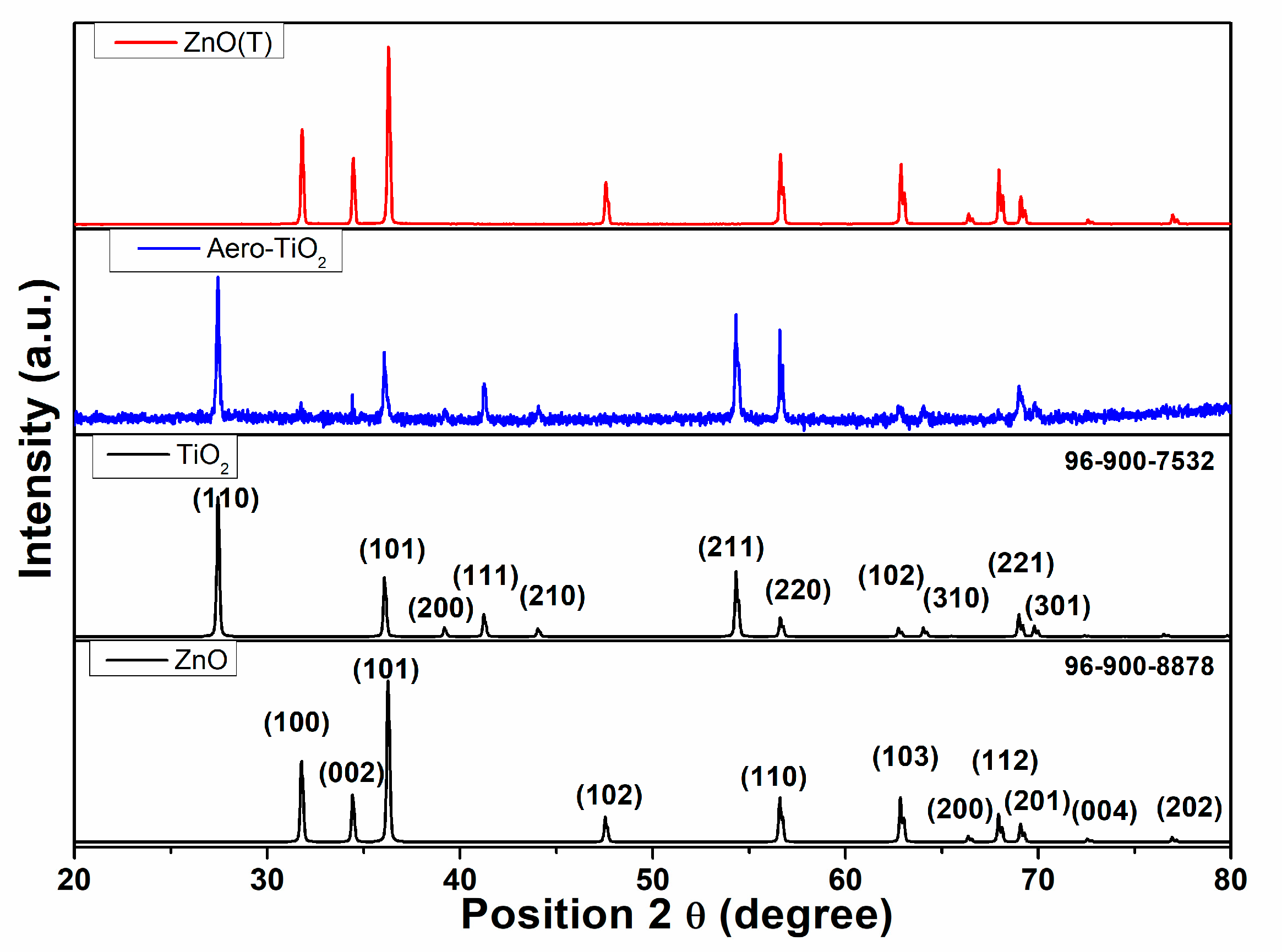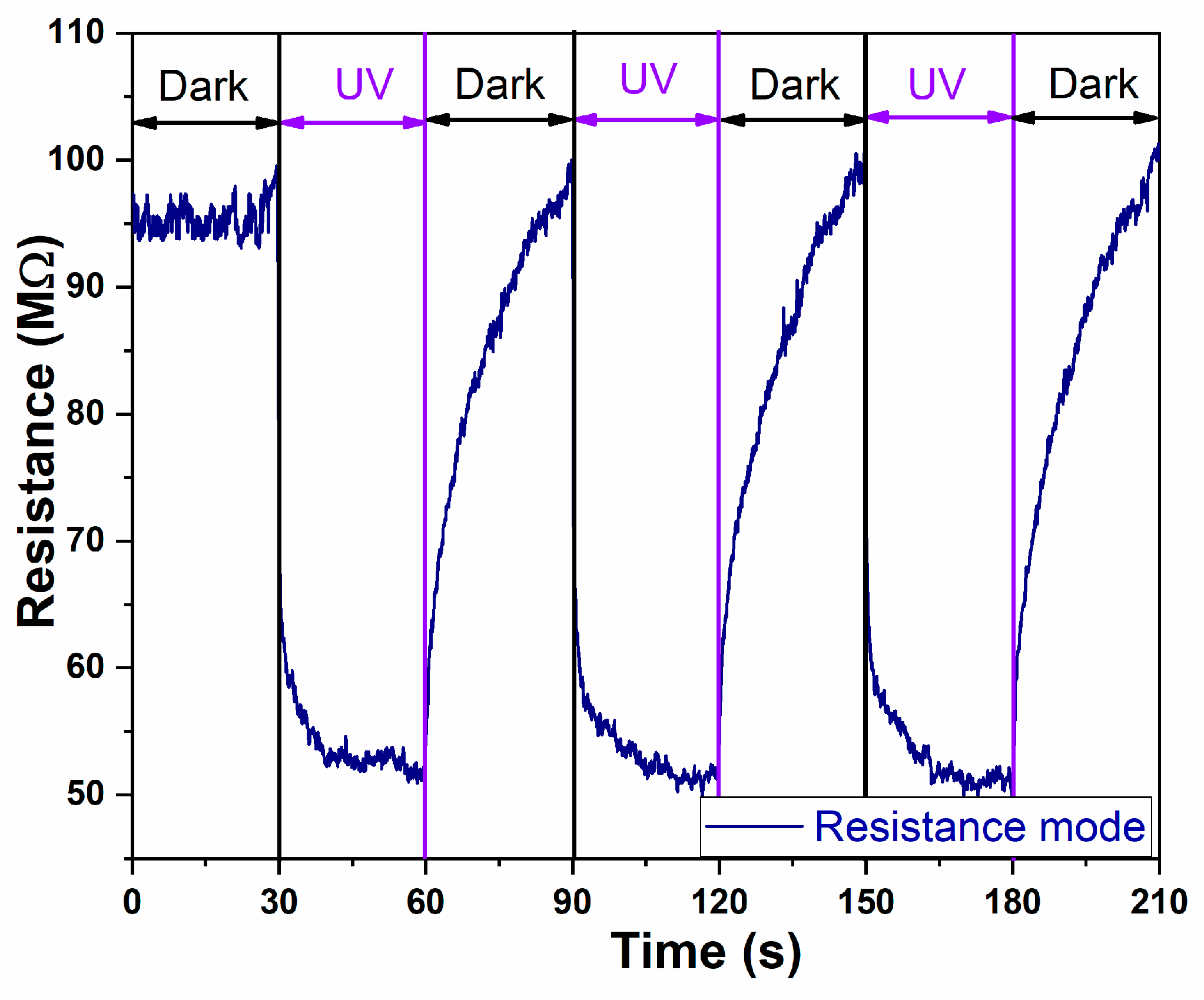Room Temperature UV Photodetector Based on Aero-Titania
Abstract
1. Introduction
2. Results and Discussion
2.1. Investigation of Morpho-Structural Properties
2.2. Optical and Electrical Characteristics
3. Materials and Methods
3.1. Synthesis of Aero-TiO2 Materials
3.2. Fabrication of Aero-TiO2 Sensor for UV Detection
3.3. Characterization Techniques
3.3.1. Morpho-Structural and Electrical Characterization
3.3.2. UV Analysis
4. Conclusions
Supplementary Materials
Author Contributions
Funding
Institutional Review Board Statement
Informed Consent Statement
Data Availability Statement
Conflicts of Interest
References
- Miller, D.R.; Akbar, S.A.; Morris, P.A. Nanoscale metal oxide-based heterojunctions for gas sensing: A review. Sens. Actuators B Chem. 2014, 204, 250–272. [Google Scholar] [CrossRef]
- Orha, C.; Nicolaescu, M.; Morariu, M.-I.; Galatonova, T.; Busuioc, S.; Lazau, C.; Bandas, C. A Comprehensive Review on Aero-Materials: Present and Future Perspectives. Coatings 2025, 15, 754. [Google Scholar] [CrossRef]
- Ursaki, V.; Braniste, T.; Marangoci, N.; Tiginyanu, I. Emerging aero-semiconductor 3D micro-nano-architectures: Technology, characterization and prospects for applications. Appl. Surf. Sci. Adv. 2025, 26, 100708. [Google Scholar] [CrossRef]
- Yang, D.; Gopal, R.A.; Lkhagvaa, T.; Choi, D. Oxidizing agent impacting on growth of ZnO tetrapod nanostructures and its characterization. Environ. Res. 2021, 197, 111032. [Google Scholar] [CrossRef]
- Paisrisarn, P.; Yasui, T.; Zhu, Z.; Klamchuen, A.; Kasamechonchung, P.; Wutikhun, T.; Yordsri, V.; Baba, Y. Tailoring ZnO nanowire crystallinity and morphology for label-free capturing of extracellular vesicles. Nanoscale 2022, 14, 4484–4494. [Google Scholar] [CrossRef]
- Li, F.; Meng, Y.; Kang, X.; Yip, S.; Bu, X.; Zhang, H.; Ho, J.C. High-mobility In and Ga co-doped ZnO nanowires for high-performance transistors and ultraviolet photodetectors. Nanoscale 2020, 12, 16153–16161. [Google Scholar] [CrossRef]
- Abubakar, S.; Ying Chyi, J.L.; Tan, S.T.; Sagadevan, S.; Talib, Z.A.; Paiman, S. Nanoscale domain imaging and the electromechanical response of zinc oxide nanorod arrays synthesized on different substrates. J. Mater. Res. Technol. 2021, 14, 2451–2463. [Google Scholar] [CrossRef]
- Bakry, M.; Ismail, W.; Abdelfatah, M.; El-Shaer, A. Low-cost fabrication methods of ZnO nanorods and their physical and photoelectrochemical properties for optoelectronic applications. Sci. Rep. 2024, 14, 23788. [Google Scholar] [CrossRef]
- Yi, C.; Yu, Z.; Ren, Q.; Liu, X.; Wang, Y.; Sun, X.; Yin, S.; Pan, J.; Huang, X. Nanoscale ZnO-based photosensitizers for photodynamic therapy. Photodiagnosis Photodyn. Ther. 2020, 30, 101694. [Google Scholar] [CrossRef]
- Wang, Y.; Coppel, Y.; Lepetit, C.; Marty, J.-D.; Mingotaud, C.; Kahn, M.L. Anisotropic growth of ZnO nanoparticles driven by the structure of amine surfactants: The role of surface dynamics in nanocrystal growth. Nanoscale Adv. 2021, 3, 6088–6099. [Google Scholar] [CrossRef] [PubMed]
- Poschmann, M.P.M.; Siebert, L.; Lupan, C.; Lupan, O.; Schütt, F.; Adelung, R.; Stock, N. Surface Conversion of ZnO Tetrapods Produces Pinhole-Free ZIF-8 Layers for Selective and Sensitive H2 Sensing Even in Pure Methane. ACS Appl. Mater. Interfaces 2023, 15, 38674–38681. [Google Scholar] [CrossRef] [PubMed]
- Padmanaban, D.b.; Maguire, P.; Mariotti, D. Non-equilibrium defect chemistry in oxygen-rich zinc oxide nano-tetrapods synthesized using atmospheric pressure microplasma. J. Mater. Chem. A 2024, 12, 9212–9231. [Google Scholar] [CrossRef]
- Dmytruk, A.; Dmitruk, I.; Shynkarenko, Y.; Belosludov, R.; Kasuya, A. ZnO nested shell magic clusters as tetrapod nuclei. RSC Adv. 2017, 7, 21933–21942. [Google Scholar] [CrossRef]
- Yan, L.; Uddin, A.; Wang, H. ZnO Tetrapods: Synthesis and Applications in Solar Cells. Nanomater. Nanotechnol. 2015, 5, 19. [Google Scholar] [CrossRef]
- Veys, E.; Makower, L.; Williamson, M.; Saure, L.M.; Adelung, R.; Schütt, F.; Pugno, N.M.; Marrow, T.J. In situ observation of compressive deformation of an interconnected network of zinc oxide tetrapods. Scr. Mater. 2023, 224, 115153. [Google Scholar] [CrossRef]
- Albulescu, D.; Ursu, D.; Rusnac, L.-M.; Nitu, S.; Miclau, M.; Vajda, M. Investigation of UV Dye-Sensitized Solar Cells Based on Water Electrolyte: A New Insight for Wavelength-Selective Greenhouse. Crystals 2022, 12, 98. [Google Scholar] [CrossRef]
- Chandoliya, R.; Sharma, S.; Sharma, V.; Joshi, R.; Sivanesan, I. Titanium Dioxide Nanoparticle: A Comprehensive Review on Synthesis, Applications and Toxicity. Plants 2024, 13, 2964. [Google Scholar] [CrossRef]
- Ciobanu, V.; Ursaki, V.V.; Lehmann, S.; Braniste, T.; Raevschi, S.; Zalamai, V.V.; Monaico, E.V.; Colpo, P.; Nielsch, K.; Tiginyanu, I.M. Aero-TiO2 Prepared on the Basis of Networks of ZnO Tetrapods. Crystals 2022, 12, 1753. [Google Scholar] [CrossRef]
- Wyckoff, R.W.G. Crystal Structures; Interscience Publishers: New York, NY, USA, 1963. [Google Scholar]
- Baur, W.H.; Khan, A.A. Rutile-type compounds. IV. SiO2, GeO2 and a comparison with other rutile-type structures. Acta Crystallogr. Sect. B 1971, 27, 2133–2139. [Google Scholar] [CrossRef]
- Holzwarth, U.; Gibson, N. The Scherrer equation versus the 'Debye-Scherrer equation'. Nat. Nanotechnol. 2011, 6, 534. [Google Scholar] [CrossRef]
- Srikant, V.; Clarke, D.R. On the optical band gap of zinc oxide. J. Appl. Phys. 1998, 83, 5447–5451. [Google Scholar] [CrossRef]
- Li, D.; Jiang, X.; Zhang, Y.; Zhang, B.; Pan, C. A novel route to ZnO/TiO2 heterojunction composite fibers. J. Mater. Res. 2013, 28, 507–512. [Google Scholar] [CrossRef]
- Mathew, S.; Ganguly, P.; Rhatigan, S.; Kumaravel, V.; Byrne, C.; Hinder, S.J.; Bartlett, J.; Nolan, M.; Pillai, S.C. Cu-Doped TiO2: Visible Light Assisted Photocatalytic Antimicrobial Activity. Appl. Sci. 2018, 8, 2067. [Google Scholar] [CrossRef]
- Lazau, C.; Nicolaescu, M.; Orha, C.; Şerban, V.; Bandas, C. Self-Powered Photodetector Based on FTO/n-TiO2/p-CuMnO2 Transparent Thin Films. Materials 2022, 15, 5229. [Google Scholar] [CrossRef]
- Ranjith, K.S.; Rajendra Kumar, R.T. Facile construction of vertically aligned ZnO nanorod/PEDOT:PSS hybrid heterojunction-based ultraviolet light sensors: Efficient performance and mechanism. Nanotechnology 2016, 27, 095304. [Google Scholar] [CrossRef]
- Gröttrup, J.; Postica, V.; Smazna, D.; Hoppe, M.; Kaidas, V.; Mishra, Y.K.; Lupan, O.; Adelung, R. UV detection properties of hybrid ZnO tetrapod 3-D networks. Vacuum 2017, 146, 492–500. [Google Scholar] [CrossRef]
- Postica, V.; Paulowicz, I.; Lupan, O.; Schütt, F.; Wolff, N.; Cojocaru, A.; Mishra, Y.K.; Kienle, L.; Adelung, R. The effect of morphology and functionalization on UV detection properties of ZnO networked tetrapods and single nanowires. Vacuum 2019, 166, 393–398. [Google Scholar] [CrossRef]
- Lin, H.; Wei, L.; Wu, C.; Chen, Y.; Yan, S.; Mei, L.; Jiao, J. High-Performance Self-powered Photodetectors Based on ZnO/ZnS Core-Shell Nanorod Arrays. Nanoscale Res. Lett. 2016, 11, 420. [Google Scholar] [CrossRef] [PubMed]
- Nagpal, R.; Lupan, C.; Bîrnaz, A.; Sereacov, A.; Greve, E.; Gronenberg, M.; Siebert, L.; Adelung, R.; Lupan, O. Multifunctional Three-in-One Sensor on t-ZnO for Ultraviolet and VOC Sensing for Bioengineering Applications. Biosensors 2024, 14, 293. [Google Scholar] [CrossRef]
- Ilickas, M.; Mardosaite, R.; Cesano, F.; Cravanzola, S.; Barolo, C.; Scarano, D.; Viscardi, G.; Rackauskas, S. ZnO tetrapod morphology influence on UV sensing properties. Nanotechnology 2024, 35, 015502. [Google Scholar] [CrossRef]
- Elsaeedy, H.I.; Qasem, A.; Yakout, H.A.; Mahmoud, M. The pivotal role of TiO2 layer thickness in optimizing the performance of TiO2/P-Si solar cell. J. Alloys Compd. 2021, 867, 159150. [Google Scholar] [CrossRef]
- Chabri, S.; Dhara, A.; Show, B.; Adak, D.; Sinha, A.; Mukherjee, N. Mesoporous CuO–ZnO p–n heterojunction based nanocomposites with high specific surface area for enhanced photocatalysis and electrochemical sensing. Catal. Sci. Technol. 2016, 6, 3238–3252. [Google Scholar] [CrossRef]
- Zhao, L.; Sun, S.; Zhang, S.; Li, X. UV activated formaldehyde gas sensing based on gold decorated ZnO@ In2O3 hollow nanospheres at room temperature. Sens. Actuators B Chem. 2024, 417, 136149. [Google Scholar] [CrossRef]
- Thepnurat, M.; Chairuangsri, T.; Hongsith, N.; Ruankham, P.; Choopun, S. Realization of Interlinked ZnO Tetrapod Networks for UV Sensor and Room-Temperature Gas Sensor. ACS Appl. Mater. Interfaces 2015, 7, 24177–24184. [Google Scholar] [CrossRef]
- Nunes, D.; Fortunato, E.; Martins, R. Flexible nanostructured TiO2-based gas and UV sensors: A review. Discov. Mater. 2022, 2, 2. [Google Scholar] [CrossRef]
- Shree, S.; Postica, V.; Voß, L.; Lupan, C.; Mishra, Y.K.; Kienle, L.; Adelung, R.; Lupan, O. Optimization of T-ZnO Process for Gas and UV Sensors. ACS Appl. Electron. Mater. 2025, 7, 3848–3863. [Google Scholar] [CrossRef]
- Knoepfel, A.; Liu, N.; Hou, Y.; Sujani, S.; dos Reis, B.R.; White, R.; Wang, K.; Poudel, B.; Gupta, S.; Priya, S. Development of Tetrapod Zinc Oxide-Based UV Sensor for Precision Livestock Farming and Productivity. Biosensors 2022, 12, 837. [Google Scholar] [CrossRef]
- Sahu, S.; Bhattacharjee, M. Nanostructured ZnO thin film-based flexible printed sensor for high-performance UV detection. Sens. Actuators A Phys. 2025, 383, 116196. [Google Scholar] [CrossRef]







| Compound | D(hkl) | Debye–Scherrer Method D (nm) | Debye–Scherrer Method Average D (nm) | Anisotropy Index (%) | Williamson–Hall Method Average D (nm) | Microstrain (ε) ×10−3 |
|---|---|---|---|---|---|---|
| TiO2 | D(110) | 66 | 79 | 14.38 | 67 | 0.183124 |
| D(101) | 94 | |||||
| D(211) | 77 | |||||
| ZnO | D(110) | 240 | 262 | 23.73 | 473 | −0.216963 |
| D(002) | 347 | |||||
| D(112) | 200 |
| Sensor | Sensibility | Responsivity A W−1 cm−2 | Response Time (s) | Recovery Time (s) |
|---|---|---|---|---|
| A1-aero-TiO2 (HIM) | 17.00 | 1.02 × 10−4 | 2.23 | 7.80 |
| A1-aero-TiO2 (LIM) | 12.50 | 1.23 × 10−4 | 2.31 | 6.90 |
| A2-aero-TiO2 (HIM) | 23.60 | 1.05 × 10−4 | 2.50 | 4.40 |
| A2-aero-TiO2 (LIM) | 9.63 | 1.04 × 10−4 | 2.70 | 3.20 |
| A3-aero-TiO2 (HIM) | 14.10 | 7.64 × 10−5 | 2.30 | 9.10 |
| A3-aero-TiO2 (LIM) | 8.87 | 9.79 × 10−5 | 2.10 | 6.10 |
Disclaimer/Publisher’s Note: The statements, opinions and data contained in all publications are solely those of the individual author(s) and contributor(s) and not of MDPI and/or the editor(s). MDPI and/or the editor(s) disclaim responsibility for any injury to people or property resulting from any ideas, methods, instructions or products referred to in the content. |
© 2025 by the authors. Licensee MDPI, Basel, Switzerland. This article is an open access article distributed under the terms and conditions of the Creative Commons Attribution (CC BY) license (https://creativecommons.org/licenses/by/4.0/).
Share and Cite
Nicolaescu, M.; Braniste, T.; Orha, C.; Morariu, M.-I.; Lehmann, S.; Nielsch, K.; Tiginyanu, I.M.; Faur, R.; Zalamai, V.; Lazau, C.; et al. Room Temperature UV Photodetector Based on Aero-Titania. Int. J. Mol. Sci. 2025, 26, 11035. https://doi.org/10.3390/ijms262211035
Nicolaescu M, Braniste T, Orha C, Morariu M-I, Lehmann S, Nielsch K, Tiginyanu IM, Faur R, Zalamai V, Lazau C, et al. Room Temperature UV Photodetector Based on Aero-Titania. International Journal of Molecular Sciences. 2025; 26(22):11035. https://doi.org/10.3390/ijms262211035
Chicago/Turabian StyleNicolaescu, Mircea, Tudor Braniste, Corina Orha, Mina-Ionela Morariu, Sebastian Lehmann, Kornelius Nielsch, Ion M. Tiginyanu, Raluca Faur, Victor Zalamai, Carmen Lazau, and et al. 2025. "Room Temperature UV Photodetector Based on Aero-Titania" International Journal of Molecular Sciences 26, no. 22: 11035. https://doi.org/10.3390/ijms262211035
APA StyleNicolaescu, M., Braniste, T., Orha, C., Morariu, M.-I., Lehmann, S., Nielsch, K., Tiginyanu, I. M., Faur, R., Zalamai, V., Lazau, C., & Bandas, C. (2025). Room Temperature UV Photodetector Based on Aero-Titania. International Journal of Molecular Sciences, 26(22), 11035. https://doi.org/10.3390/ijms262211035








